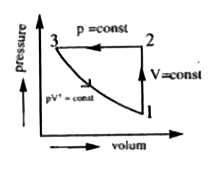A perfect gas undergoes the following three separate and distinct processes to execute a cycle
(i) constant volume process during which 80 kJ of heat is supplied to the gas,
(ii) constant pressure process during which 85 kJ of heat is lost to the surroundings and 20 kJ of work is done on it.
(iii) adiabatic process which restores the gas back to its initial stage.
Evaluate the work done during adiabatic process and the value of internal energy at all the state points if initially its value is 95 kJ.
This example illustrates the application of nonflow energy equation and the 1st law applied to a cyclic process.

Process 1 -2 : Q1−2=80kJ,W1−2=0
U2−U1=Q1−2−W1−2
=80−0=80kJ
U2=80+95=175kJ
Process 2-3:
Q2−3=−85kJ,W2−3=−20kJ
U3−U2=Q2−3−W2−3=−85−(−20)=−65kJ
U3=−65+175=110kJ
For the complete cycle : ∮δQ=∮δW. That is
Q1−2+Q2−3+Q3−1=W1−2+W2−3+W3−1
80−85+0=0+(−20)+W3−1
∴ Work done during adiabatic process,
W3−1=15kJ
Similar Questions
A closed system receives 200kJ of heat at constant volume. It then rejects 100kJ of heat while it has 50kJ of work done on it at constant pressure. If an adiabatic process can be found which will restore the system to its initial state, the work done by the system during this process is
View SolutionA gas undergoes a change of state during which 100J of heat is supplied to it and it does 20J of work. The system is brough back to its original state through a process during which 20 J of heat is released by the gas. What is the work done by the gas in the second process?
View Solution
Knowledge Check
A closed system receives 200kJ of heat at constant volume. It then rejects 100kJ of heat while it has 50kJ of work done on it at constant pressure. If an adiabatic process can be found which will restore the system to its initial state, the work done by the system during this process is
A100kJB50kJC150kJD200kJAn ideal gas system undergoes an isothermal process, then the work done during the process is
AnRTln(V2V1)BnRTln(V1V2)C2nRTln(V2V1)D2nRTln(V1V2)An ideal gas system undergoes an isothermal process, then the work done during the process is
AnRTln(V2V1)BnRTln(V1V2)C2nRTln(V2V1)D2nRTln(V1V2)
A gas undergoes a change of state during which 100J of heat is supplied to it and it does 20J of work. The system is brough back to its original state through a process during which 20 J of heat is released by the gas. What is the work done by the gas in the second process?
View SolutionA diatomic gas undergoes same change of temperature by two different processes (i) at constant volume and (ii) at constant pressure. The heat supplied in the two cases will be in the ratio of
View SolutionA system undregoes a change of state during which 100kJ of heat is transferred to it and it does 50kJ of work. The system is brought back to its original state through a process during which 120kJ of heat is transferred to it. Find the work done by the system in the second process.
View SolutionAn ideal gas system undergoes an isothermal process, then the work done during the process is
View SolutionA diatomic gas undergoes same change of temperature by two different processes (i) at constant volume and (ii) at constant pressure. The heat supplied in the two cases will be in the ratio of
View Solution
